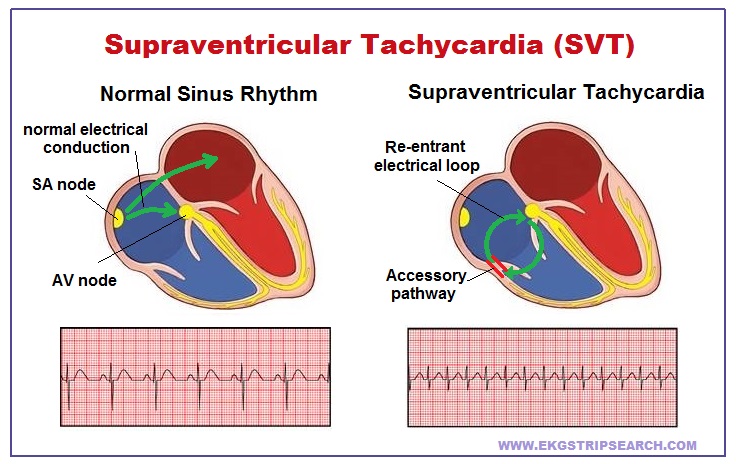Supraventricular tachycardia is an abnormal rhythm with a very fast heart rate (140 to 240 bpm). It's
caused by improper electrical activity, or an accessory pathway within the heart. It originates above
the ventricles at the AV node, or from within the atria. This abnormal accessory pathway allows the
electrical signal once it has gone through the atria, and through the AV node down into the ventricles,
to re-enter back up into the atria. This re-entrant electrical activity causes a short circuit loop to
circulate continually around, which paces the heart at a very fast rate (see illustration below).

The name "supraventricular" is sometimes confusing because part of its name uses the term; "ventricular".
All ventricular rhythms normally have a wide QRS, and yet SVT has a narrow QRS. First, it is best to
understand what the term "supraventricular" means. The name simply describes the location of the problem.
The term "supra" simply means above.
The term ventricular stands for "ventricles".
Supraventricular means "above the ventricles" (the origin of the problem).
And of course, tachycardia means a fast heart rate (SVT heart rate >140).
Supraventricular Tachycardia is an electrical looping malfunction happening above the ventricles, causing a very fast heart rate.
Supraventricular tachycardia does not describe one particular rhythm.
It's more like an "Umbrella Name" that covers a group of different atrial tachycardias
and other re-entrant tachycardias as well. There are two types of SVT categories;
Most common "re-entrant". And also "automaticity driven", which are self generated by electrical stimulation. SVT rhythms are listed below;
Re-entrant and reciprocating; (The two most common types of SVT with very long names!):
- Atrioventricular reentrant tachycardia (AVRT)
- Atrioventricular nodal reentrant tachycardia (AVNRT)
- And don't forget paroxysmal SVT (PSVT) which starts and stops abruptly such as; "a run of PSVT".
Automaticity driven SVT;
- Atrial Tachycardia.
- Junctional ectopic tachycardia.
- Atrial Flutter
- Some SVTs with automaticity may have a gradual increase and decrease in the heart rate,
due to being in an area of the heart that generates its own electrical signal.
Have you ever noticed;
Say you have a 15 beat run of PSVT that starts off at a slower rate and increases
faster as it goes.. And you think, hmmm.. isn't SVT supposed to be regular? Why is this irregular?
Is it a 15 beat run of A Fib with rvr? (maybe). However, SVT rhythms that are Automaticity Driven
can sometimes have variable rates that speed up or slow down. Whereas re-entrant SVTs
(mostly atrial tachycardias) will have a solid uniform fast rate.
Signs and symptoms;
- The faster the heart rate, the more symptomatic and threatening it can be.
- Shortness of breath
- Chest pain
- Rapid breathing
- Dizziness
- Loss of consciousness (in extreme cases)
Return to Home Page
|


